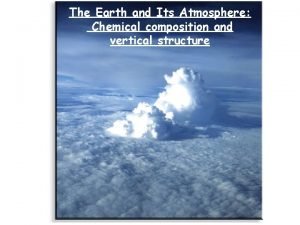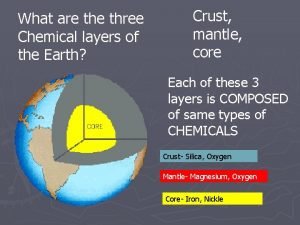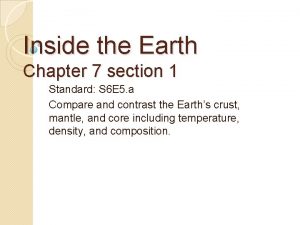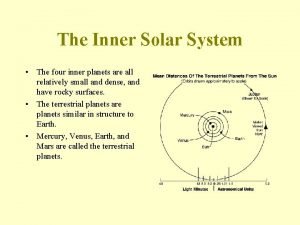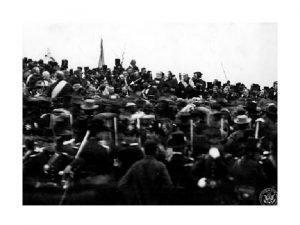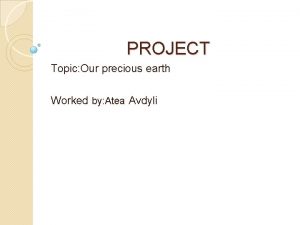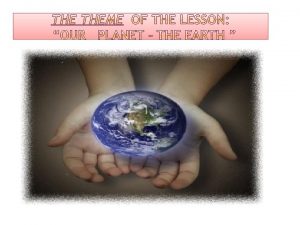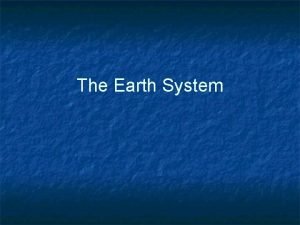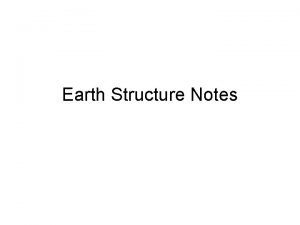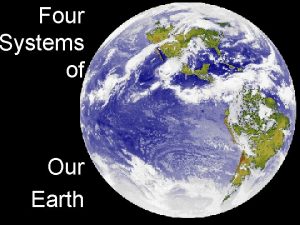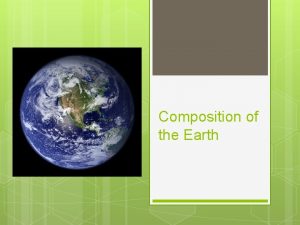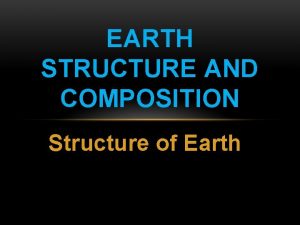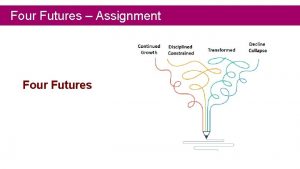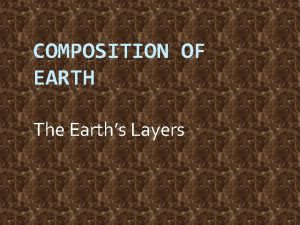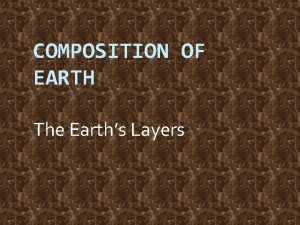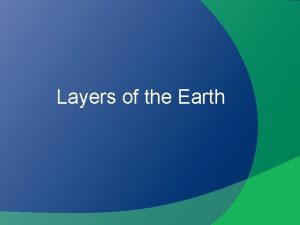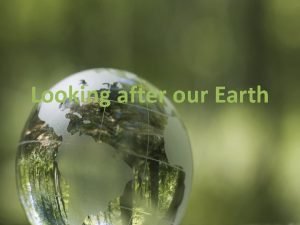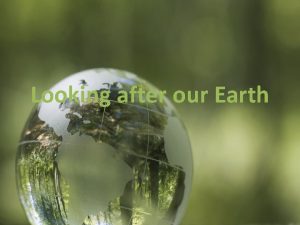Four Systems of Our Earth Composition of Earth


































- Slides: 34

Four Systems of Our Earth

Composition of Earth l Earth Has 4 main systems that interact: Earth’s systems Atmosphere Hydrosphere Biosphere Geosphere Air/gases water life land/rock

The Atmosphere– layer of gas that surrounds Earth more commonly known as “air”.

Atmosphere. How do you know its there l l Is this “air” that surrounds us considered matter? Does it weigh anything? How do you know? Think about it and decide on an answer. Talk in groups with the person who sits by you Be ready to tell the class what you decided and why.

Weight of the atmosphere l l l Gases are in the atmosphere. They are things we learned about in the periodic table: Nitrogen, Oxygen, Carbon Dioxide, Hydrogen It is matter! Sound can travel through it.

Even though you can’t see them, Atoms make up gases. l l Are some atoms bigger than others? Are their atomic weights all the same?

Helium vs. Carbon Dioxide Do you think of helium as light and floating or heavy and falling? Do you think about Carbon Dioxide as light and floating or heavy and falling…. think about the gas released from dry ice… does it go up or down? http: //jp. youtube. com/watch? v= F 239 c. INIADs

l Composition of Earth Has 4 main systems that interact: l The Atmosphere l Mostly Nitrogen and Oxygen l Water vapor is responsible for clouds and precipitation l Has layers l Protects us from meteors and comets, x-rays, gamma rays, ultra violet light l The Hydrosphere The Biosphere The Geosphere l l

Atmosphere Exosphere-- Thermosphere-- Mesosphere-- Stratosphere-- Troposphere

Composition of Earth’s atmosphere l Earth Has 4 main systems that interact: l The Atmosphere l layers § § § l l Exosphere Thermosphere Mesosphere Stratosphere Troposphere The Hydrosphere The Biosphere The Geosphere Exosphere

Composition of Earth’s atmosphere l Earth Has 4 main systems that interact: l The Atmosphere l Troposphere § § § Stratosphere l Mesosphere l Thermosphere The Hydrosphere The Biosphere The Geosphere l l Contains most clouds and weather. Temperature cools as you go higher 50% of sun’s energy passes through, 50% is reflected back. Most of the troposphere’s heat is from Earth (convection) Exosphere

Atmosphere Exosphere-- Thermosphere-- Mesosphere-- Stratosphere-- Contains most clouds and weather. Temperature cools as you go higher 50% of sun’s energy passes through, 50% is reflected back. Most of the troposphere’s heat is from Earth (convection) Troposphere--

Troposphere and Clouds l l Among other gases there is water vapor in the troposphere. Clouds—form when air rises, cools to its dew point, and becomes saturated (moist).

Water Vapor Demonstration

Water Cycle Demo

l Precipitation-falling water in the form of rain, freezing rain, sleet, snow, or hail

Section 2: Earth’s Weather Troposphere l l Weather—the atmosphere’s condition in terms of temperature, cloud cover, wind speed and direction, humidity, and air pressure. What are different types of weather? ___________________________________

Section 2: Earth’s Weather Troposphere Temperature—a measure of how fast air molecules are moving. l l l When molecules are moving rapidly, temperature is high. Celsius and Fahrenheit thermometers measure air temperature.

Section 2: Earth’s Weather Troposphere l l What is the temperature like today? Hot/ Cold ___________ Degrees Fahrenheit________ Degrees Celsius _________

Section 2: Earth’s Weather Troposphere Energy is transferred between fast-moving molecules and slower-moving molecules. l l Give an example of something heating up due to conduction: _________________ l l l Conduction—transfer of energy when molecules collide. Convection occurs when warm air rises and cool air sinks. Give an example of something heating up due to convection: __________________

Section 2: Earth’s Weather Troposphere Air pressure— air weight that varies over Earth’s surface. l l l Warmer air is less dense and exerts less pressure. Cooler air is more dense and exerts more pressure.

Air Pressure Demonstration— Write about what you learned

l l Humidity— the amount of water vapor in the air Temperature affects how much moisture is in the air.

l l Dewpoint—when the air is holding as much water vapor as it can Relative humidity— a measure of the amount of water vapor present compared to the amount that could be held at a specific temperature.

THAT WAS ALL ABOUT THE TROPOSPHERE!!! Lets cover the other layers briefly. l Go back up to the graphic organizer at the top of your notes and fill in info about each layer. l Atmosphere Exosphere-- Thermosphere-- Mesosphere-- Stratosphere-- Troposphere

Composition of Earth’s atmosphere l Earth Has 4 main systems that interact: l The Atmosphere l l Troposphere Stratosphere § § § l l l 10 km to 50 km contains ozone that absorbs much of the Sun’s ultraviolet radiation. Gets warmer as you go up. Mesosphere Thermosphere The Hydrosphere The Biosphere The Geosphere

Atmosphere Exosphere-- Thermosphere-- Mesosphere- Stratosphere--10 km to 50 km , contains ozone that absorbs much of the Sun’s ultraviolet radiation. , Gets warmer as you go up. Troposphere--Contains most clouds and weather. Most of the troposphere’s heat is from Earth Temperature cools about 6. 5 degrees Celsius per kilometer of altitude.

Composition of Earth’s atmosphere l Earth Has 4 main systems that interact: l The Atmosphere l Troposphere l Stratosphere l Mesosphere § 50 -85 km The coldest part of the atmosphere. It can get down to -90°C in the mesosphere. § Thermosphere § l l l The Hydrosphere The Biosphere The Geosphere

Atmosphere Exosphere-- Thermosphere-- Mesosphere- 50 -85 km, The coldest part of the atmosphere. It can get down to -90°C in the mesosphere. - Stratosphere--10 km to 50 km , contains ozone that absorbs much of the Sun’s ultraviolet radiation. , Gets warmer as you go up. Troposphere--Contains most clouds and weather. Most of the troposphere’s heat is from Earth Temperature cools about 6. 5 degrees Celsius per kilometer of altitude.

Composition of Earth’s atmosphere l Earth Has 4 main systems that interact: l The Atmosphere l l Troposphere Stratosphere Mesosphere Thermosphere § § l l l 80 -500 km Temperatures increase up to 1, 700°C Filters out x-rays and gamma rays from the sun. This is an image of the space shuttle as it is orbiting around the Earth. The space shuttle orbits in thermosphere of the Earth. The Hydrosphere The Biosphere The Geosphere

Atmosphere Exosphere-Thermosphere-- 80 -500 km, Temperatures increase up to 1, 700°C, Filters out x-rays and gamma rays from the sun. , This is an image of the space shuttle as it is orbiting around the Earth. The space shuttle orbits in thermosphere of the Earth. Mesosphere--The temperature drops when you go higher, like it does in the troposphere. Coldest part of the atmosphere Stratosphere--from 10 km to 50 km above Earth’s surface, this layer contains ozone that absorbs much of the Sun’s ultraviolet radiation. Troposphere--Contains most clouds and weather. , Most of the troposphere’s heat is from Earth, Temperature cools about 6. 5 degrees Celsius per kilometer of altitude.

Exosphere l l l The last layer of the atmosphere Difficult to tell where it stops and space begins Very few atoms in this layer of the atmosphere

Atmosphere Exosphere--The last layer of the atmosphere, Difficult to tell where it stops and space begins, Very few atoms in this layer of the atmosphere Thermosphere-- The air is really thin that high up. The temperature changes with the solar activity. If the sun is active, temperatures in thermosphere can get up to 1, 500°C or higher! Mesosphere--The temperature drops when you go higher, like it does in the troposphere. Coldest part of the atmosphere Stratosphere--from 10 km to 50 km above Earth’s surface, this layer contains ozone that absorbs much of the Sun’s ultraviolet radiation. Troposphere--Contains most clouds and weather. , Most of the troposphere’s heat is from Earth, Temperature cools about 6. 5 degrees Celsius per kilometer of altitude.

Ionosphere l Within the mesosphere and thermosphere is a layer of electrically charged particles. This layer allows radio waves to travel across the country to another city. l www. bloust. com/henley
 Thinking affects our language which then affects our
Thinking affects our language which then affects our Our census our future
Our census our future Bernadette farrell christ be our light
Bernadette farrell christ be our light Marcus aurelius our life is what our thoughts make it
Marcus aurelius our life is what our thoughts make it We bow our hearts we bend our knees
We bow our hearts we bend our knees Our census our future
Our census our future Our life is what our thoughts make it
Our life is what our thoughts make it We quail money makes us quail
We quail money makes us quail Our awareness of ourselves and our environment
Our awareness of ourselves and our environment Awareness of ourselves and our environment is:
Awareness of ourselves and our environment is: God our father christ our brother
God our father christ our brother Our future is in our hands quotes
Our future is in our hands quotes Our awareness of ourselves and our environment.
Our awareness of ourselves and our environment. Awareness of ourselves and our environment
Awareness of ourselves and our environment Structure of atmosphere
Structure of atmosphere Mesosphere earth layer composition
Mesosphere earth layer composition Earth different layers
Earth different layers Composition of the earth's crust
Composition of the earth's crust The four inner planets of our solar system are
The four inner planets of our solar system are Four scores and seven years ago
Four scores and seven years ago How many years are four score and seven
How many years are four score and seven Our precious earth
Our precious earth I promise to save the earth
I promise to save the earth Permanent winds
Permanent winds Our earth class 2 ppt
Our earth class 2 ppt Oh lord our lord how excellent is thy name in all the earth
Oh lord our lord how excellent is thy name in all the earth This insulates our earth from the deep cold of space
This insulates our earth from the deep cold of space Our fragile earth reflection
Our fragile earth reflection Our fragile earth reflection
Our fragile earth reflection Economics unit 1 lesson 2 difficult choices
Economics unit 1 lesson 2 difficult choices Kandinskey
Kandinskey Four eyes skin assessment tool
Four eyes skin assessment tool How can you compare the terrarium to an earth system
How can you compare the terrarium to an earth system What are the four spheres of the earth
What are the four spheres of the earth Layers of the earth convection currents
Layers of the earth convection currents














